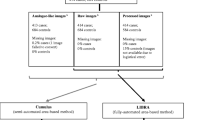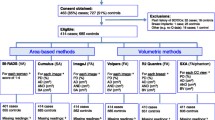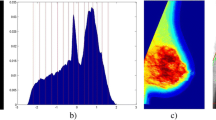Abstract
Purpose
The ImageJ model is a recently developed automated breast density measurement tool based on analysis of Cumulus outcomes. It has been validated on digitized film-screen mammograms. In this study, the ImageJ model was assessed on processed full-field digital mammograms and correlated with the Breast Imaging Reporting and Data System (BI-RADS) density classification. Also, the association with breast cancer risk factors is observed.
Methods
Women with mammographies between 2001 and 2011 at the University Medical Center Utrecht, The Netherlands were included. We composed a training set, read with Cumulus, for building the ImageJ model [n = 100 women, 331 images; craniocaudal (CC) and mediolateral oblique (MLO) views, left and right] and a validation set for model assessment and correlation with the BI-RADS classification [n = 530 women, 1,977 images; average of available CC and MLO views, left and right]. Pearson product-moment correlation coefficient was used to compare Cumulus with ImageJ, Spearman correlation coefficient for ImageJ with BI-RADS density, and generalized linear models for association with breast cancer risk factors.
Results
The correlation between ImageJ and Cumulus in the training set was 0.90 [95 % confidence interval (CI) 0.86–0.93]. After application to the validation set, we observed a high correlation between ImageJ and the BI-RADS readings (Spearman r = 0.86, 95 % CI 0.84–0.88). Women with higher density were significantly younger, more often premenopausal, had lower parity, more often a benign breast lesion or family history of breast cancer.
Conclusions
The ImageJ model can be used on processed digital mammograms. The measurements strongly correlate with Cumulus, the BI-RADS density classification, and breast cancer risk factors.



Similar content being viewed by others
References
Boyd NF, Guo H, Martin LJ, Sun L, Stone J, Fishell E et al (2007) Mammographic density and the risk and detection of breast cancer. N Engl J Med 356(3):227–236
McCormack Va, dos Santos, Silva I (2006) Breast density and parenchymal patterns as markers of breast cancer risk: a meta-analysis. Cancer Epidemiol Biomark Prev 15(6):1159–1169
Kerlikowske K (2007) The mammogram that cried Wolfe. N Engl J Med 356(3):297–300
Nothacker M, Duda V, Hahn M, Warm M, Degenhardt F, Madjar H, Weinbrenner SAU (2009) Early detection of breast cancer: benefits and risks of supplemental breast ultrasound in asymptomatic women with mammographically dense breast tissue. A systematic review. BMC Cancer 20(9):335
Kavanagh AM, Byrnes GB, Nickson C, Cawson JN, Giles GG, Hopper JL, Gertig DMED (2008) Using mammographic density to improve breast cancer screening outcomes. Cancer Epidemiol Biomark 10:2818–2824
Benndorf M, Baltzer PA, Vag T, Gajda M, Runnebaum IBKW (2010) Breast MRI as an adjunct to mammography: does it really suffer from low specificity? A retrospective analysis stratified by mammographic BI-RADS classes. Acta Radiol 51:715–721
Berg WA, Zhang ZLD et al (2012) Detection of breast cancer with addition of annual screening ultrasound or a single screening MRI to mammography in women with elevated breast cancer risk. JAMA 307(13):1394–1404
Reston V (1993) American College of Radiology: breast imaging reporting and data system (BIRADS). Am Coll Radiol
Yaffe MJ (2008) Mammographic density. Measurement of mammographic density. Breast Cancer Res 10(3):209
Boyd NFML (2011) Mammographic density and breast cancer risk: current understanding and future prospects. Breast Cancer Res 13:223
Byng JW, Boyd NF, Fishell E, Jong Ra, Yaffe MJ (1994) The quantitative analysis of mammographic densities. Phys Med Biol 39(10):1629–1638
Shepherd JA, Herve L, Landau J, Fan B, Kerlikowske KCS (2005) Novel use of single X-ray absorptiometry for measuring breast density. Technol Cancer Res Treat 4(2):173–182
Shepherd JA, Kerlikowske K, Ma L, Duewer F, Fan B, Wang J, Malkov S, Vittinghoff ECS (2011) Volume of mammographic density and risk of breast cancer. Cancer Epidemiol Biomark 20(7):1473–1482
Kallenberg MGJ (2011) Automatic breast density segmentation: an integration of different approaches. Phys Med Biol 56:2715–2729
Highnam R, Brady M, Yaffe MJKN (2010) Robust breast composition measurement—Volpara (TM). Digit Mammogr 6136:342–349
Van Engeland S, Snoeren PR, Huisman H, Boetes CKN (2006) Volumetric breast density estimation from full-field digital mammograms. IEEE Trans Med Imaging 25(3):273–282
Li J, Szekely L, Eriksson L, Heddson B, Sundbom A, Czene K et al (2012) High-throughput mammographic-density measurement: a tool for risk prediction of breast cancer. Breast Cancer Res 14(4):R114
Heine JJ, Carston MJ, Scott CG, Brandt KR, Wu F, Pankratz VS et al (2008) An automated approach for estimation of breast density. Cancer Epidemiol Biomark Prev 17:3090–3097
Pawluczyk O, Augustine BJ, Yaffe MJ, Rico D, Yang J, Mawdsley GEBN (2003) A volumetric method for estimation of breast density on digitized screen-film mammograms. Med Phys 30(3):352–364
Nickson C, Arzhaeva Y, Aitken Z, Elgindy T, Buckley M, Li M et al (2013) AutoDensity: an automated method to measure mammographic breast density that predicts breast cancer risk and screening outcomes. Breast Cancer Res 15(5):R80
ImageJ, U.S. National Institutes of Health, Bethesda, MD, USA. http://imagej.nih.gov/ij/
Sovio U, Li J, Aitken Z, Humphreys K, Czene K, Moss S et al (2014) Comparison of fully and semi-automated area-based methods for measuring mammographic density and predicting breast cancer risk. Br J Cancer 20:1–9
Ihaka R, Gentlemen RR (1997) The R Project for Statistical Computing [Internet]. Statistics Department of the University of Auckland. http://www.r-project.org/
Carney PA, Miglioretti DL, Yankaskas BC, Kerlikowske K, Rosenberg R, Rutter CM et al (2003) Individual and combined effects of age, breast density and hormone replacement therapy use on the accuracy of screening mammography. Ann Intern Med 138:168–175
Acknowledgments
This work was supported by the Agency for Science, Technology, and Research (A-STAR), Singapore under the 2nd Joint Council Office (JCO) Career Development Grant (13302EG065). We thank Mariette Lokate (M.L.) for providing a cohort of images with Cumulus density estimations for this study.
Author information
Authors and Affiliations
Corresponding author
Rights and permissions
About this article
Cite this article
Couwenberg, A.M., Verkooijen, H.M., Li, J. et al. Assessment of a fully automated, high-throughput mammographic density measurement tool for use with processed digital mammograms. Cancer Causes Control 25, 1037–1043 (2014). https://doi.org/10.1007/s10552-014-0404-4
Received:
Accepted:
Published:
Issue Date:
DOI: https://doi.org/10.1007/s10552-014-0404-4




